
While there are plenty of social media platforms to choose from, Meta, and Facebook in particular, remains the best platform to leverage for any crowdfunding campaign.
Why? Facebook has an extensive user base and versatile promotional tools.
As of July 2023, Facebook has 2.934 billion monthly active users and 2.04 billion daily active users. These users spend an average of 33 minutes on Facebook daily, and 81% only access the platform via mobile devices.
With these kinds of numbers, a well-planned and targeted campaign on Facebook has the potential to reach an enormous audience.
What’s more, a wide range of demographics use Facebook, so you’re sure to reach almost any targeted group.
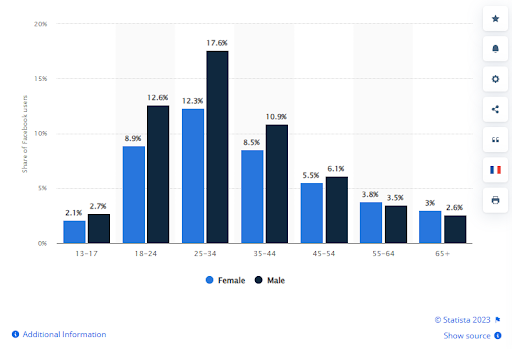
Facebook users worldwide by age and gender
Facebook’s advertisement infrastructure is also among the most sophisticated. They provide in-depth targeting options. You can reach users based on factors such as:
- Interests
- Location
- Age
- Gender
- Specific behaviors
Additionally, Facebook’s Cost Per Click (CPC) advertising model is more affordable than traditional advertising methods, especially when the campaign is well-targeted.
We can keep listing reasons why Facebook is a powerful tool for crowdfunding. But in this article, we want to look at specific ways that you can use it to drive your crowdfunding campaign to success… and even use it for post-campaign.
Here are some specific ways to use Facebook for your crowdfunding campaign:
- Use Facebook in the Testing Phase
- Build a Qualified Pre-Launch Email List with Facebook
- Using Facebook for Live Campaign Ads
- Use Facebook to Drive Sales to Indiegogo InDemand
- Use Facebook for eCommerce
Contents
Drive traffic to your campaign with facebook paid ads
Of course, this is the most important reason for using Facebook — to drive traffic to your campaign.
The more people see your campaign, the more potential backers you attract. It’s a simple equation. Higher visibility equates to more backers, which, in turn, results in increased funding.
Unlike organic reach, which can fluctuate and be somewhat unpredictable, paid ads enable you to maintain sustained, reliable traffic throughout your campaign.
But there are so many platforms to advertise on. Are we saying Facebook is the best?
YES. Comparing the ROI of Facebook Ads with other social media platforms, Facebook leads with 22% of respondents saying that Facebook was the social media platform with the highest return on investment.
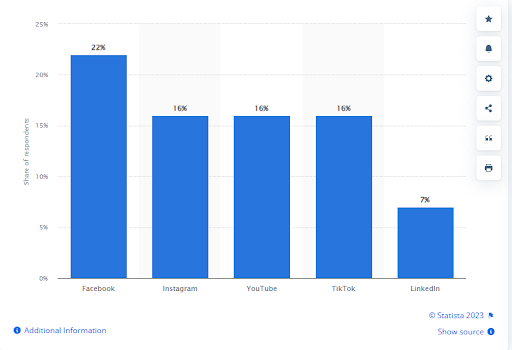
Social media platforms’ return on investment (ROI)
Note, however, that the ROI from Facebook Ads can vary significantly depending on factors such as the quality of your ad, your targeting, and the general interest in your project.
So, how do you use Facebook to drive traffic to your campaign?
Using Facebook in the testing phase
At LaunchBoom, we call this the TestBoom phase.
If you have been following us or have read my book Crowdfunded, then you might have heard of the TestBoom stage.
The TestBoom phase serves as a litmus test for your crowdfunding campaign. It’s all about gauging interest, refining your messaging, and understanding your audience better before you fully plunge into your campaign.
But most importantly, it’s about validating your idea and confirming that there’s a willing and eager market for your project.
Here’s how TestBoom works with Facebook:
- Run Test Ads – Use Facebook’s ad system to run test ads. These ads help you understand which messaging resonates with your audience, who exactly your audience is, and what kind of interest there is in your project.
- Analyze – Analyze which demographics responded best, which aspects of your project excited people, and which parts of your messaging fell flat.
- Adust – Use the insights gained from your test ads and feedback to refine your product’s positioning or pivot your product if necessary.
To show you how we use Facebook for the test phase, we’ll use the example of SPRYNG, from the Crowdfunded book, a muscle recovery tool.
Heshika, the creator of this product, thought it would be a big hit with athletes needing a fast, efficient recovery solution after rigorous training sessions.
But here’s the catch: this was an assumption. As exciting as the product was, we didn’t yet know if the target audience—athletes, in this case—would actually be interested.
As always, we turned to Facebook to help us gather the needed data.
First, we came up with some initial hypotheses about how this product would be positioned in the market.
- You believe athletes are your key demographic, but could other potential audiences exist?
- Could the muscle recovery tool also appeal to individuals who lead sedentary lives and struggle with circulation issues?
We created two ads sets targeting athletes and people with circulation problems due to a sedentary lifestyle:
Athletes Ad: “Monster leg sessions in the gym, long days at the office, and marathon runs… Spryng is there for you, ready to aid your recovery and make you feel great, no matter what!”
Ad for people with circulation problems: “Almost 90% of the blood returning to your heart from your veins comes from your calves. Exercise and long bouts of sitting/standing can weaken the muscles, which makes them less effective in moving the blood, which can result in a lot of swelling and pain (known as blood pooling). This recovery tool focuses on actively compressing that area to help get that blood moving!”
Once the ads went live, we closely monitored the responses.
- How are people reacting to your ads?
- Which demographic is showing more interest?
Eventually, we found that ads targeted toward those with circulation issues resonated more than those directed at athletes.
Do you see how Facebook is important for our test strategy? The client was able to use real data to see which positioning performed better. This saved our client from incurring losses further in the process.
Also, the Facebook Ads during the test phase don’t take a lot of budget.
For example, for the Author Clock campaign (another one of our success stories), we spent $2,027 on ads during the test phase.
With this testing budget, we were able to test different ad creative & copy, landing page designs, and audiences to target on Facebook.
Through careful and strategic use of Facebook during your campaign’s testing phase, you can mitigate risk, validate hypotheses, and gather the insights you need to launch a successful crowdfunding campaign.
Using Facebook to build a qualified pre-launch email list
One secret to success when crowdfunding is having a pre-qualified email list before you even launch your campaign.
This is not just any list of email addresses but one filled with people who can’t wait to buy your product.That’s because this email list is full of people who have also put down a $1 deposit to reserve the best launch deal.
We call this technique the reservation funnel. We have found that people on the reservation list are 30x more likely to purchase when we launch than non-reservations.
We use Facebook (Meta) ads to build this reservation list.
Simply, here is how the reservation funnel works:
- Launch captivating ads on Facebook – This is your first touchpoint with potential backers, an ad on platforms like Facebook or Instagram.
- Landing page sign-up – The main goal of your landing page is to invite visitors to sign up using their email addresses for launch notifications.
- The VIP offer bridge – After the visitor signs up with their email, they are presented with a special opportunity — a chance to become a “VIP” backer by placing a deposit of $1.
- VIP reservation checkout – If visitors decide to take up your VIP offer, they are directed to a checkout page where they can place their reservation deposit. The reservation secures their VIP status and the special benefits that come with it.
Now, to get the most out of Meta Advertising, it’s essential to get three key elements right:
- Targeting the right audience
- Creating attention-grabbing imagery
- Crafting engaging copy
Targeting
You must target the right audience.
If you misdirect your efforts, you will fail to meet your desired metrics, and you risk wasting resources and building a list that won’t convert effectively.
To get targeting right, use this simple exercise we call “Creating Your Dream 20”. Here, you imagine a scenario where 20 brands of your choice are promoting your product to all their customers via email.
You want to leverage their hard work for your benefit.
Here’s one more brainstorming framework we love to use. We call it the Four F’s framework. Ask yourself the following questions to come up with more specific interests to target.
- Who does your market follow?
What specific influencers or people does your audience follow? Instead of targeting “entrepreneurs,” target Gary Vaynerchuk, Tim Ferriss, Fast Company, and so on.
- Where does your audience frequent?
Where do they spend their time? Instead of targeting “fitness,” target 24-Hour Fitness, Ironman, CrossFit Games, etc.
- What do they do for fun?
What activities does your audience like? Instead of targeting “outdoors,” target hiking, backpacking, camping, etc.
- What particular products do they fund?
What do they spend their money on? Instead of targeting “running,” target Adidas, FitBit, RoadRunner, etc.
Next, armed with your Dream 20, you’re ready to build your audiences on Facebook.
We recommend two basic types of audiences: Interest audiences, derived from your Dream 20, Meta’s Suggestion Engine, and Lookalike audiences, which use existing audiences/email lists to generate similar audiences.
Creating Interest audiences is a straightforward process. Go to your Meta Ads Manager and click Audiences.
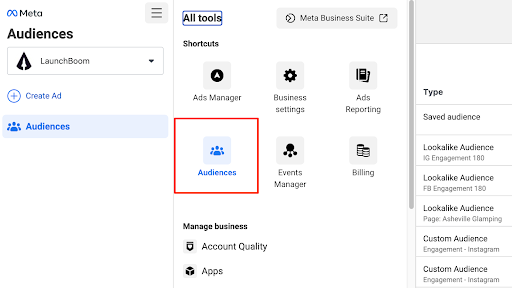
Next, click Create Audience and Saved Audience.
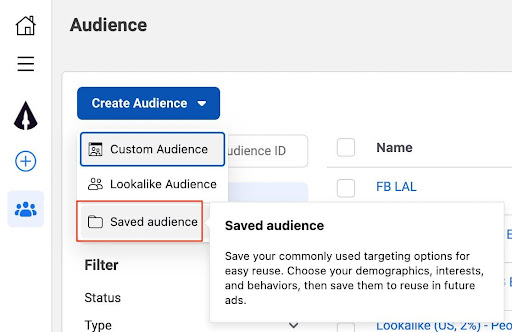
Specify basic demographic information like age, gender, location, and language.
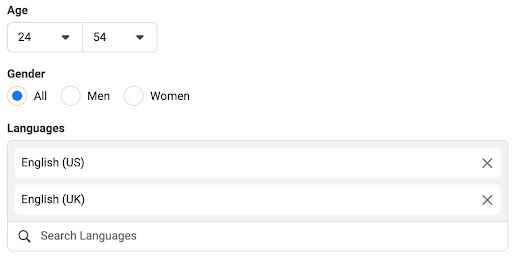
Next, on the “Detailed targeting” box, enter one of your interest audiences.

Then click on Suggestions. Meta will provide suggestions for other relevant interests. Click on these suggestions to add them. Stop when the potential audience reaches around 12 to 15 million people.
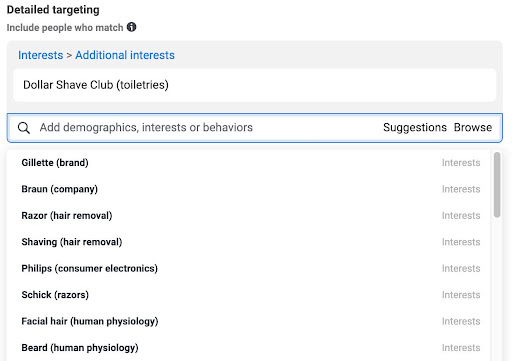
That is how you do effective targeting on Meta.
Creating attention-grabbing Imagery
You do not need to have professional imagery to create a successful ad for Meta. On the contrary, we found that non-professional, authentic-looking imagery performs better.
On Facebook & Instagram, people are not looking to be sold to by a company. When they see an image that looks polished, they immediately think “ad.” We don’t want them to think that way. Instead, use imagery that looks natural in their feed yet still evokes curiosity for them to click.
Here are a few examples of what I mean.
Example 1: Testimonial
Shoot a vertical video using your phone of someone using your product and then giving a testimonial. You don’t want to edit the video at all so it looks as natural and real as possible.
The ad below is from our campaign, Xion eBike, which raised $1,104,152 on Indiegogo.
This ad imagery worked so well that we spent $48,337.04 just on this one ad in the prelaunch.
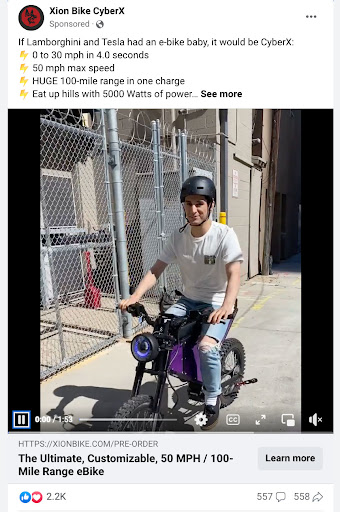
Example 2: Founder walkthrough
Another very popular ad type is what I call the Founder Walkthrough video. In this ad type, the founder is filmed unpackaging the product and showing how it works. Like the previous ad, it is shot vertically on a phone and there are no cuts.
Here’s an example from our campaign, X300 Projector, which raised $239,098 on Indiegogo.
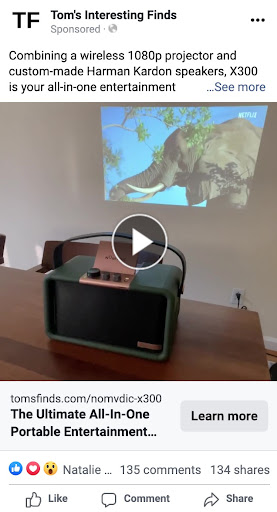
Example 3: Red arrow
Another very popular ad type is a static image but with a little tiny red arrow pointing to it. Yes, that little red arrow actually works well. We’ve tested the exact same image, one with the red arrow and one without the red arrow, and the red arrow always wins.
Here’s an example from our campaign, Author Clock, which raised $2,217,773 on Kickstarter and Indiegogo InDemand.
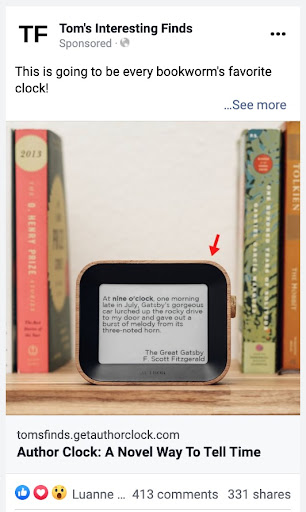
What’s the commonality?
The three examples above are responsible for driving millions of dollars in revenue for 3 campaigns. The commonality between all of them is that they were very simple to make. We didn’t spend thousands of dollars on high-end production. We actually shot two of them using a phone!
Also, I recommend using Canva to create your ads — it’s free!
Crafting an engaging copy
The copy or text of your ad engages viewers and inspires them to take action.
The two most important elements of your ad copy are (1) the top text section and (2) the bottom headline. You can see an example below from our campaign, TidyBoard, which raised $612,395 on Kickstarter.
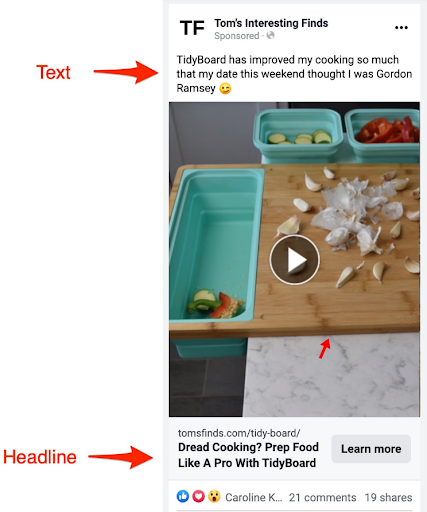
Users often scroll through their feeds quickly on social media platforms like Facebook. Your top text needs to be engaging enough to make them stop scrolling and pay attention to your ad.
The Bottom Headline is the call to action (CTA) part of your ad. It’s your chance to tell viewers exactly what you want them to do next. It should be concise, clear, and compelling. Phrases like “Get Yours Now”, “Join Us”, or “Back Us Today” work well.
Expert Tip: Always keep your copy product-focused. People are interested in what your product does and how it can benefit them.
Using Facebook for live campaign ads
As you transition from the pre-launch phase to the live campaign phase, Facebook plays a crucial role in your crowdfunding success, specifically through Live Campaign Ads.
At this stage, you are not just remarketing. You want to target a new audience to help keep the momentum of your campaign going.
Creating successful ads for this live campaign phase requires carefully crafting both the ad copy and ad creative.
When creating the ad copy, use the following:
- Social proof from the ongoing campaign – Highlight key metrics such as the amount raised or the time taken to reach the funding goal.
- Real-time campaign updates – For example, mention recent milestones achieved, new perks or rewards added, or any limited-time offers available.
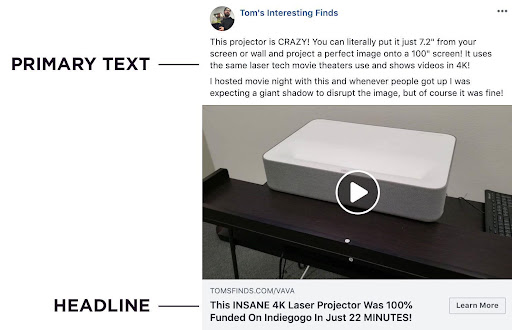
Using Facebook to drive sales to Indiegogo InDemand
In this step, we use a combination of Facebook and Indiegogo InDemand.
Even after your formal crowdfunding campaign ends, Indiegogo InDemand allows you to keep raising funds, continue growing your community, and keep the project’s visibility high.
Leverage Facebook ads to target potential backers who may have missed your initial campaign.
This phase of advertising also helps you expand your audience further by reaching people who have similar interests to your existing backers or are part of your lookalike audiences.
Here are the steps to successfully integrate Facebook with Indiegogo InDemand to maintain sales momentum:
- Re-evaluate Your Ad Strategy – You’ll no longer have the urgency of a limited-time campaign to leverage, so focus more on the unique selling points of your product and the credibility you’ve built during your campaign.
- Use Lookalike Audiences – Continue to utilize Facebook’s lookalike audiences feature, but this time based on people who contributed during your crowdfunding campaign. These individuals will likely have similar interests and may be willing to back your project in the InDemand phase.
- Leverage User Testimonials – Incorporate testimonials from backers who received their product during the campaign into your Facebook ads. Real-life user experiences are compelling and can help convert potential backers.
Expert Tip: At this stage, also ask Indiegogo’s team if you can get placement in their newsletter They will likely give you a funding milestone you need to hit in order to “unlock” the newsletter placement.
Next, drive traffic to your Indemand campaign through Facebook ads. Once you’ve reached the set funding milestone, you’ll gain a spot in Indiegogo’s newsletter. This promotion can significantly boost your campaign’s visibility, potentially resulting in a considerable surge in sales.
Conclusion
Facebook ads play a key role in the various stages of your crowdfunding campaign, through the initial testing phase, pre-launch, live campaign, and ultimately Indiegogo InDemand.
In the initial testing phase, Facebook provides a vast platform for reaching out to a diverse audience and gathering essential feedback about your product. As you transition into pre-launch, Facebook is integral in helping you build a qualified pre-launch email list through an effective reservation funnel.
The live campaign phase sees a shift in Facebook’s advertising strategy, focusing on larger audience targeting and employing ad copy that leverages social proof, urgency and scarcity. For post-campaign Indiegogo InDemand sales, Facebook advertising can effectively generate additional revenue in tandem with Indiegogo’s promotions.
But we know getting started on a crowdfunding journey can be daunting. At LaunchBoom, we turn your product ideas into highly successful campaigns on crowdfunding platforms like Kickstarter and Indiegogo. Talk to our experts today and tell us more about your product. Not ready to chat yet? I suggest you take a look at our success stories to see what other creators were able to accomplish with LaunchBoom’s support.




